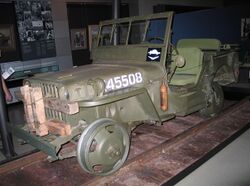Engineering:Jeep train

A jeep train usually refers to a line of coupled railway vehicles hauled by a jeep fitted with railway wagon wheels instead of normal road wheels. World War II jeeps were converted from road vehicles into steel-wheeled rail switchers, shunters, light locomotives, speeders or draisines.[2] The phrase was also used for supply trains consisting of jeeps and for columns of jeeps linked together and pulled through bad ground by tractors. Not all primary sources will use this phrase in the same way. Colloquially, the term jeepomotive has been used on several occasions.[3][4][5][6]
History
United States
Adapting automobiles as gasoline railcars is recorded as early as 1912[8] and early publicity on Jeeps mentioned their potential use as an inspection car.[9] The United States Army Air Forces in Australia used flanged-wheel jeeps as switchers in 1943, which led to testing as road-switchers for future operations in New Guinea. Perhaps the first large-scale use of jeep as locomotive was in the CBI theatre.[10] Eleven days after the Normandy landing, jeep speeders were in use on the continent, surveying lines for use or repair.[11] Postwar, jeep speeders were used as inspection cars, and jeep trains used for light service, including recreation. The Jeep train at Lewis and Clark Caverns claimed to be the shortest jeep railway.[12] Over time, hi-rail vehicles pushed dedicated speeders out of railroads; civilian jeeps were often used.
Australia
In Borneo in 1945, Australian soldiers converted jeeps to run on rails in order to compensate for the lack of locomotives on a narrow gauge railway line.[13]
United Kingdom
The United Kingdom used railworthy Jeeps during World War II especially in France, Germany, and Burma. Jeep trains were used extensively during the Malayan Emergency.
France
French forces used rail jeeps – "jeep draisines" – including armoured rail jeeps, in Indochina, and later in the Algerian war.
Loads and speeds
A jeep, designed to draw 1,000 lb (450 kg) on the road, could pull much greater loads on rails thanks to the lower rolling resistance of rail vehicles. During Australian military operations in Borneo, jeeps hauled goods wagons with a payload of four tons of sand. In the Philippines , a jeep train hauled a total weight of 52 tons over a route 19 miles (31 km) long at a speed of 20 mph (32 km/h).
Military use
See also
References
- ↑ Truck 1/4 Ton 4x4 GS, jeep: Australian Army Military History Section.
- ↑ Nevington War Museum: USA - Jeep Variants - Railway Jeeps.
- ↑ Aboard the Jeepomotive Express. Australian servicemen using the jeep railway in Sabah, 1945. Photo: Geelong Advertiser. Reproduced in Light Railways, No 135, January 1997, page 16.
- ↑ Like the tiny but powerful ant, the "jeepomotive" carries, pushes or pulls many times its own weight. The makers set the haulage maximum at 1,000 pounds, but "jeepomotives" have been known to draw a three-ton truck laden with four tons of sand on this system. Squadron leader Jack Liberty of Perth, WA, adapted the Jeep by designing special attachment to the wheels of Japanese motor transports and by modifying the standard Jeep axle to take these wheels and track the one-metre gauge. Officially the average speed of the Jeep-train has been set at fifteen miles per hour but army drivers always seem to run to time in spite of any delays on the route. North Borneo. 1945-08-01.
- ↑ Jeeptrain: "Jeep engine of one of the strangest railways in the world—in Borneo, between Jesselton, Beauford, and Melalap, covering 116 miles of one-metre gauge. Fighter-bombers and retreating Japs took heavy toll of locomotives and rolling stock, and an RAAF engineer designed a substitute locomotive, producing the 'jeepomotive.'" The Mercury, 3 September 1945. In: The University of Dayton Alumnus, January 1945. University of Dayton Magazine, 1 January 1945, page 7.
- ↑ Class Notes: "1940— Maj. Earl Wiley has the task of re-establishing railroad operations on Luzon. Instead of the conventional locomotive Earl converted a jeep into a "Jeepomotive" as the motive power of the narrow gauge railroad to Manila."
- ↑ Testing in Australia.
- ↑ "Highest Voltage Transmission System in the World". Electrical World 59 (16): 846. April 20, 1912. https://books.google.com/books?id=Ad5QAAAAYAAJ&pg=PA846. Retrieved 15 July 2015.
- ↑ Magazines, Hearst (November 1942). "Miracle on Wheels". Popular Mechanics: 82. https://books.google.com/books?id=rNYDAAAAMBAJ&pg=PA82.
- ↑ Boyd Sinclair: Running On Time In a Timeless Land: An elephant can be a locomotive and a tiger sometimes stopped a train.
- ↑ Newell, Clayton R.. "Railroaders in Olive Drab: The Military Railway Service in World War II". http://wbachapter.org/files/MilitaryRailwayService.pdf. Retrieved 11 August 2015.
- ↑ "Lewis and Clark caverns state park : Park management plan, public review draft". 2000. https://archive.org/stream/mgmtplanlewiscla00montrich/mgmtplanlewiscla00montrich_djvu.txt.
- ↑ Australian War Memorial, Reference No OG3138.
External links
 |










